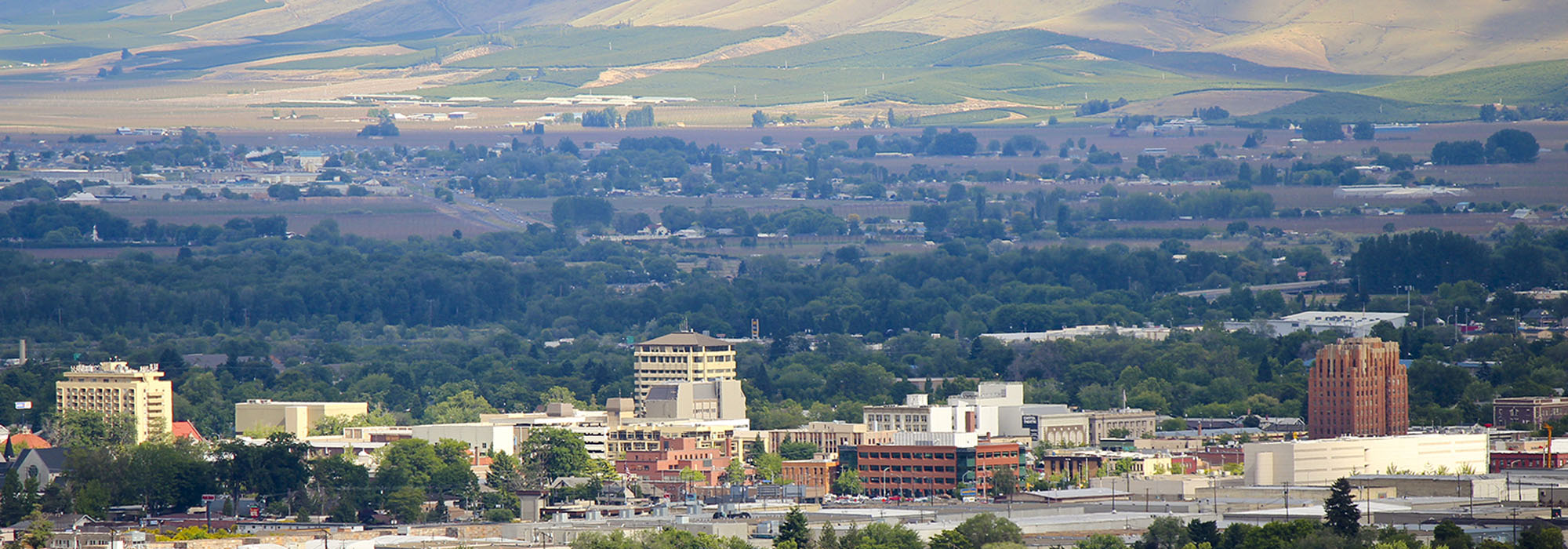Did you know there are nearly 140 different community indicators on Yakima Valley Trends - each updated throughout the year? But which ones, and when?
This issue of the Yakima Valley Trends blog lists some of the most recently updated indicators on the Yakima Valley Trends website.
This page will be updated and email alerts sent on a quarterly basis. Don't miss an update - subscribe today!
Recent Updates
In PEOPLE:
At 67%, the turnout for the elections last November in was the lowest since the start of the century. Additionally, in recent presidential election years, average turnout has rested well below Washington average. (Last November, the state turn-out rate was 79%.) However, at the turn of the century, Yakima County’s turn-out was on a par with that of the state.
The highest turnout for presidential elections in recent years took place in 2020.
To view only the presidential election years, click the legend elements “midterm” and “off-year.”
In AGRICULTURE:
Land in farms in Yakima County has remained remarkably constant.
By several measures, agriculture remains the linchpin of the county economy. To produce the volume of crops and animal products, land is required. And unlike many agricultural communities, the land devoted to these pursuits has not diminished over the years.
The USDA tracks agricultural land use via its Census of Agriculture, conducted every 5 years. The most recent results, for 2022 and released last year, showed 1.8 million acres in agriculture in the county. That’s nearly two thirds (65%) and a higher share than 25 years ago.
In ECONOMIC VITALITY:
Washington is one the largest exporting states in the nation, recently ranking 8th, by value. While Boeing aircraft may grab the export headlines, Yakima County contributes significantly to the state as well.
In 2023, the most recent year for which complete data are available, the county exported slightly more than $1.2 billion of goods abroad. As the graph reveals, the largest share was and has consistently been Agricultural Products, followed by Processed Foods. The 2023 results marked a return to “normal” after the pandemic. The peak year, however, was 2014, when the county exported $1.3 billion of goods.
To simplify the graph, click in the legend on those items you would like to hide.
Residential building permitted units in Yakima County continued to slump in 2024.
The construction industry, whether building residential or commercial projects, is one of the key drivers of a local economy. Residential construction also delivers a product that most communities desperately need – housing, whether single- or multi-family. This indicator tracks the level of permits issued annually as well as a population-based rate.
Apart from three out of the past 15 years, the annual number of permitted units for the county has rested at well below 750. As the graph shows, the number include single-family residence and multi-family permitted units. The gap between the Washington and U.S. rates versus Yakima County’s rate of permitted units per 1,000 residents has been large. In 2024, the rate was 2 per 1,000 residents. While higher than in the “teens,” the rate remains lower than 20 years ago.
To simplify the graph, click in the legend on those items you would like to hide.
In EDUCATION:
The extended graduation rate for public high school students in the county shows little change.
Graduating from high school marks an important milestone in a student’s life. The rate at which students graduate is also a key indicator of the school district’s efforts. This indicator tracks the success of a cohort in receiving a diploma after 4 or 5 years of high school. The extended rate is usually slightly higher than the “on-time,” or four-year rate.
For the most recent cohort, who were 9th graders in the fall of 2019 and graduated either in 2023 or 2024, the extended graduation rate among all public districts in the two counties was nearly 83%. This share is the third highest on record. Still, this implies than nearly one fifth of all the county’s public-school students did not graduate within five years. Recent rates have overall been a bit lower than the Washington average.
In EDUCATION: cont.
The premium of lifetime earnings that post-secondary education claims over a stopping with a high school diploma is quite clear. It has been and continues to be large. Recent research from New York Federal Reserve Bank economists shows that even considering tuition costs and the “opportunity” costs of forgoing work to study, in their case four years, post-secondary education is worth it for the average student.
This indicator measures the share of public high school seniors in the county who attend either a two- or four-year school – public or non-for-profit private -- within a year of graduation. (The year indicates graduation year.)
As the graph shows, a dramatic decline has recently occurred, largely paralleling the pandemic. The class of 2009 represented the peak of college-going, at 57%. Contrast this to the class of 2022, at 43%. For all years, the share of graduates in the county’s public schools who go on to some form of post-secondary education has trailed the state average, sometimes by as high as 10 percentage points.
To simplify the graph, click in the legend on those items you would like to hide.
In ENVIRONMENT:
The overall water quality index of the Yakima River has both improved and declined.
The Washington Department of Ecology has developed an index of surface water quality, taken at certain stations on a river. The index combines values for temperature, turbidity, fecal-coliform bacteria, heavy metals, phosphorus and dissolved oxygen, and other components. 100 represents an optimal reading; 80-100 is noted of “little concern”, while values less than 80 are of concern. Daily values are averaged over all days of a year.
The station on the Yakima River used for this indicator is at Nob Hill. The most recent annual value was 80. This represents a substantial decline from the peak reached in 2020 and 2021 of 90. Over the past 25 years, the index read at Nob Hill has slightly improved.
This is not the case further downstream, however. When the water quality index of the Yakima River at Kiona is measured, the most recent value was 51, representing a significant decline over the past two decades.
In EQUITY, INCLUSION:
Seniors living in poverty in Yakima County has unfortunately increased since the pandemic.
Living in poverty is a challenge for anyone. But for older adults (ages 65+), there is an additional dimension: time. In contrast to younger adults, this age group typically cannot look forward to improving their incomes, as they are at the end of their career, retired, or dealing with a disability.
Unfortunately, the pandemic appears to have shifted up the number and rate of older adults living at or below the poverty threshold. For the most recently available year, Census estimated that nearly 5,000 seniors in the county lived at or below the poverty line. (For a family of one, the threshold in 2024 was $15,060; for a family of two, $20,440.) The rate for this population was 13%, higher than in the state or the U.S.
This number and rate represent a shift upward from pre-pandemic years.
In HEALTH:
Good health depends on many factors, not the least of which is the socio-economic background in which a person lives. But clinical care matters, too. If a resident has no provider that sees that person on a regular basis, health can be compromised.
This indicator tracks the share of those residents who responded affirmatively to the question “Do you have one person (or more than one person) you think of as your personal doctor or health care provider?”
For the most recent year with data (2022), 79% of county residents answered “yes.” That is the highest share on record. Still, the percentage is a bit lower than the average state affirmative response, about 83% for 2022.
The number of Medicaid-insured County residents remains very high.
Since the 1960s, Medicaid has served to insure low-income Americans. For years, its focus was young children, expectant mothers and the non-elderly disabled. Since the passing of the Affordable Care Act (ACA), the program’s aperture has widened to include able-bodied but low-income adults. In Washington state, the threshold under which one currently qualifies is a monthly income of $2,901 for an individual and $5,802 for a family with both spouses applying for Medicaid.
For 2023, Census estimated that over 95,000 residents of Yakima County were insured by Medicaid. This represents over 37% of the county population. The total and rate are the third highest on record. As the graph clearly shows, the rate here since the implementation of the ACA lies far above the rates for the U.S. and Washington state. In 2023, they were both an estimated 21%.
list updated 02.03.25
New Intern Features

Alanna Mesecher
Hometown: Valley, WA
Major: Accounting
Expected Graduation Date: Spring 2025
Post-graduation plans: Start looking for a career with a CPA firm, or a non-profit organization.
After a few months of working on the Trends project, my favorite thing so far:
I enjoy collecting data and learning new information. Collecting and providing data that helps community leaders make important decisions is very rewarding, and I’m thankful to be a part of it.

Jimena Ramos
Hometown: Royal City, Washington
Major: Data Analytics
Expected Graduation Date: Spring 2025
Post-graduation plans: Find a job in Spokane or Tri-Cities
After a few months of working on the Trends project, my favorite thing so far:
My favorite thing is the opportunity to see the impact of our work and how it influences strategic decisions. It’s been interesting diving deep into data analysis and learning new skills. I’ve enjoyed collaborating with Dr. Jones, Dr. Cullen, and the other interns as they’re a great team!
The complete list of Yakima Valley Trends can be found here.
